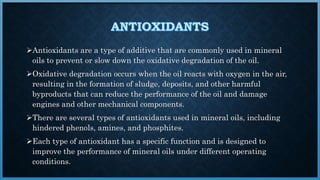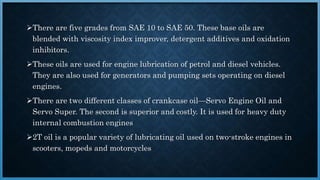LUBRICATING OILS
- 1. DEPARTMENT OF MECHANICAL ENGINEERING 3210 DHARMESH KAHIRE 3212 SHUBHAM KHATAL 3204 SAGAR KALE 3205 SANKET KALE 3206 VAIBHAV KARLE AMRUTVAHINI COLLEGE OF ENGINEERING NEAR PUNE NASHIK HIGHWAY, AHMEDNAGAR, SANGAMNER, MAHARASHTRA 422608
- 2. o Lubricating oils are a type of oil that are used to reduce friction and wear between two surfaces in contact with each other. o These oils are used in a variety of machinery, including engines, gearboxes, and hydraulic systems
- 3. (i) It should be available in a wide range of viscosities. (ii) (ii) There should be little change in viscosity of the oil with change in temperature. (iii)(iii) The oil should be chemically stable with the bearing material and atmosphere at all temperatures encountered in the application (iv) The oil should have sufficient specific heat to carry away frictional heat, without abnormal rise in temperature. (v) It should be commercially available at reasonable cost.
- 4. Mineral oils Vegetable or Animal oils
- 5. Mineral oils are a class of oils derived from petroleum or crude oil, which is a complex mixture of hydrocarbons. These oils have been used for a variety of purposes, such as lubrication, fuel, and as a source of chemicals for many industrial processes. Mineral oils have been used for thousands of years, with evidence of their use dating back to ancient civilizations such as the Greeks and Romans
- 6. Mineral oils consist of hydrocarbons, which are obtained by the distillation of crude oil. There are two different classes of mineral oils—those with a paraffinic series and those with a naphthenic series. A paraffinic oil is composed of straight and branched chains of hydrocarbons defined by the general formula CnH(2n + 2). A naphthenic oil is composed of a saturated single-ring formation of hydrocarbons defi ned by the general formula CnH2n.
- 8. The Society of Automotive Engineers (SAE) of USA has classified lubricating oils by a number, which is related to the viscosity of the oil in Saybolt Universal Seconds. This classification is based on only one property of lubricating oils, namely, viscosity. According to this system, automotive oils are classified in accordance with Table 16.5 It can be observed from this table that the SAE number corresponds to approximately one-half of the viscosity of oil at 210°F measured in terms of SUS. When the SAE number is more, it indicates more viscous oil. The viscosities in the above table are measured at only one fixed temperature, i.e. 210°F. It does not indicate the full picture of the viscosity– temperature relationship. It is, therefore, necessary to specify viscosities of these oils at a low temperature.
- 9. This is achieved by specifying viscosities at 0°F as shown in the following table: The letter W in the above table indicates winter grading of oils.
- 10. Vegetable and animal oils are a class of oils that are derived from plant and animal sources, respectively. These oils have been used for a variety of purposes, such as food, fuel, and as a source of chemicals for many industrial processes. The use of vegetable and animal oils dates back thousands of years, with evidence of their use in ancient civilizations such as the Egyptians and Greeks.
- 11. Vegetable oils used for lubrication are castor oil, rapeseed oil, palm oil and olive oil. Lubricating oils of animal origin are lard oil, tallow oil and certain oils obtained from marine species, such as whales, sperms or dolphin jaws. They are biodegradable and have low toxicity, which makes them a good choice for environmentally sensitive applications. However, vegetable oils typically have lower oxidation stability than mineral or synthetic oils, which means they can break down more easily over time and form deposits.
- 12. (i) Mineral oils are chemically inert. (ii) They have a wide range of viscosities, corresponding to different values of n in the general formula. (iii) They have little tendency to oxidise or form corrosive acids. (iv) After periodic fi ltration, they can be reused without any loss or change of their properties. (v) At normal temperature, they are not liable to spontaneous ignition
- 13. (i) These oils are sometimes referred to as fixed oils because they are non- volatile, unless there is chemical decomposition. This property prevents them from being expelled from intimate contacts of solid surfaces by frictional heat. (ii) They retain their viscosities at high temperature much better than mineral oils. (iii) These oils are called ‘polar’ compounds. They have a long chain of molecules with positive and negative charges at the two ends. One end of the polar molecule adheres to the surface of the journal or bearing and the long chain of molecules extends into clearance space. They form ‘clusters’ which prevents metal to metal contact in boundary lubrication
- 14. (i) At low temperature, these oils solidify and become ‘fats’. The fat is melted at about 65°C and becomes oil. (ii) These oils react with oxygen in the atmosphere and become acidic. In some cases they change from the liquid state to an elastic solid form. Due to this reason, they are termed ‘drying oils’. (iii)They are subjected to saponifi cation either by contact with base metals or with hot water. They produce glycerol and some organic acids, which attack metallic surfaces and form metallic soaps.
- 15. 1) Castor oil was used in the past as a lubricant in racing cars and aero-engines. 2) Rapeseed oil is added to mineral oil to increase viscosity. Cottonseed oil is mainly used as a thickener in mineral oils. 3) Lard oil is used as cutting oil, while tallow oil is used as cylinder oil. 4) In light machine tools, sperm oil is used for spindle
- 16. Mineral oil additives are chemical compounds that are added to mineral oils to improve their performance and properties. Mineral oils are derived from petroleum or crude oil, and are widely used in various applications such as lubrication, hydraulic fluids, and heat transfer fluids. However, mineral oils have certain limitations in terms of their properties, such as low viscosity index, poor thermal stability, and low resistance to oxidation and corrosion.
- 17. Detergents Dispersants Anti-wear agents Extreme pressure agents Viscosity index improvers Pour point depressants Antioxidants Corrosion inhibitors
- 18. • Detergents are a type of additive that are commonly used in mineral oils to improve their cleaning properties. • Detergents are organic compounds that have the ability to dissolve and remove contaminants from surfaces, including engine parts and other mechanical components.
- 19. Dispersants are a type of additive that are commonly used in mineral oils to improve their ability to disperse and suspend contaminants, such as soot, dirt, and other particles. Dispersants are organic compounds that have the ability to absorb onto the surface of contaminants and prevent them from clumping together and forming deposits. There are two main types of dispersants used in mineral oils: ash- containing dispersants and ashless dispersants. Ash-containing dispersants contain metal compounds and are typically used in older engine designs, while ashless dispersants do not contain metal compounds and are commonly used in newer engine designs.
- 20. Anti-wear agents are a type of additive that are commonly used in mineral oils to reduce friction and wear between moving parts in engines and other mechanical components. Anti-wear agents are typically organic compounds that form a protective layer on the surface of metal parts, helping to prevent direct contact and reduce friction and wear. There are several types of anti-wear agents used in mineral oils, including zinc dialkyldithiophosphate (ZDDP), boron compounds, and molybdenum compounds Each type of anti-wear agent has a specific function and is designed to improve the performance of mineral oils under different operating conditions
- 21. Extreme pressure agents are a type of additive that are commonly used in mineral oils to reduce friction and wear under high pressure and load conditions. Extreme pressure agents are typically organic compounds that form a protective layer on the surface of metal parts, helping to prevent direct contact and reduce friction and wear even under extreme operating conditions. There are several types of extreme pressure agents used in mineral oils, including sulfur compounds, phosphorus compounds, and chlorine compounds. Each type of extreme pressure agent has a specific function and is designed to improve the performance of mineral oils under different high-pressure and high-load operating conditions
- 22. A viscosity index improver is a substance which when added to mineral oils, increases viscosity at high temperatures. These additives are polymerized resins of high molecular weight, such as polyisobutylene, polymethacrylate ester and polyfumarite ester. The popular VI improver is ‘paratone’ which is a polymer of butylene having the formula (C4H8)n where n varies from 180 to 270. Due to the large size of the molecule, the additive has extremely high viscosity. When added to the base oil, it increases viscosity at high temperature. At low temperature, the molecules are coiled and remain as colloidal suspension in the base oil. As the temperature increases, they uncoil, go into solution and increase its viscosity. This improves the viscosity index of the base oil. Normally, 1 to 2 per cent VI improver is added to the base oil.
- 23. Pour point is the lowest temperature at which the oil can flow. This is an important characteristic when the lubricant is used in refrigeration and air-conditioning equipment. Mineral oils of paraffinic origin contain some amount of wax. When the temperature decreases below the pour point, the wax is separated in the form of needle shaped crystals. These crystals join with each other and form a matrix. The oil is held in the matrix in much the same fashion as water is retained in sponge. The mineral oil, therefore, ceases to function as a fluid. ‘Paraflow’ is used as a pour point depressant. This type of additive surrounds the wax crystals in the form of a coating and prevents them from forming a large size matrix. The small-size crystals remain in suspension, but do not affect the fl uidity of the base oil.
- 24. Antioxidants are a type of additive that are commonly used in mineral oils to prevent or slow down the oxidative degradation of the oil. Oxidative degradation occurs when the oil reacts with oxygen in the air, resulting in the formation of sludge, deposits, and other harmful byproducts that can reduce the performance of the oil and damage engines and other mechanical components. There are several types of antioxidants used in mineral oils, including hindered phenols, amines, and phosphites. Each type of antioxidant has a specific function and is designed to improve the performance of mineral oils under different operating conditions.
- 25. Corrosion inhibitors are a type of additive that are commonly used in mineral oils to prevent or reduce the corrosion of metal parts in contact with the oil. Corrosion can occur when the oil reacts with moisture, acids, or other corrosive substances, leading to the formation of rust, scale, or other harmful byproducts that can damage engines and other mechanical components. There are several types of corrosion inhibitors used in mineral oils, including organic and inorganic compounds. Each type of corrosion inhibitor has a specific function and is designed to improve the performance of mineral oils under different operating conditions.
- 26. Lubricating oils are commercially available under different trade names. Indian Oil Corporation5 manufactures a wide range of lubricating oils and greases. These commercial lubricants contain a base oil and a group of additives, which are suitable for a given application. The properties of lubricating oils used for automotive applications are given in Table 16.6.
- 27. There are five grades from SAE 10 to SAE 50. These base oils are blended with viscosity index improver, detergent additives and oxidation inhibitors. These oils are used for engine lubrication of petrol and diesel vehicles. They are also used for generators and pumping sets operating on diesel engines. There are two different classes of crankcase oil—Servo Engine Oil and Servo Super. The second is superior and costly. It is used for heavy duty internal combustion engines 2T oil is a popular variety of lubricating oil used on two-stroke engines in scooters, mopeds and motorcycles
- 28. (i) 2T oil, also known as two-stroke oil, is a type of lubricant that is specifically designed for use in two-stroke engines. (ii) Two-stroke engines are commonly used in small handheld equipment such as chainsaws, leaf blowers, and motorcycles. (iii)The composition of 2T oil is typically a blend of mineral or synthetic base oils, combined with various additives such as detergents, dispersants, and anti-wear agents. (iv) The specific composition of 2T oil can vary depending on the requirements of the engine manufacturer, as well as the operating conditions in which the engine is used
- 29. (i) It is self-mixing with petrol. (ii) It keeps the piston, piston rings, cylinder, plugs and exhaust port clean. (iii) It prevents corrosion of engine components. (iv) It controls deposits in the combustion chamber and reduces pre-ignition. It consists of SAE 30 as base oil, and detergent additives. The recommended fuel/oil ratio varies from 12:1 to 50:1 depending upon the engine.
- 31. Commercial lubricating oils for gears consist of SAE 80, SAE 90 and SAE 140 as base oils and a mixture of extreme-pressure additives, oxidation inhibitors and oiliness additives. The properties of these oils are given in Table 16.7































